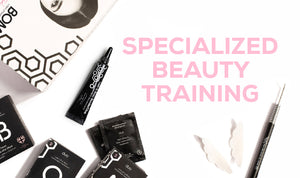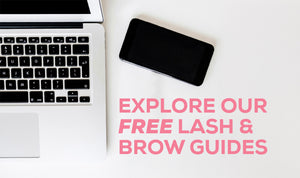Beautiful Brows & Lashes Blog
Lash Shields vs. Lash Rods: Which Is Better?
Many lash technicians take one side of the argument when choosing lash shields or rods for a lash lift. But the truth is, you really should plan to stock both!
When working on a customer's lashes, the whole point is to tailor the experience to their needs and desired outcome, right? With that in mind, if you have both lash shields and lash rods available, you're prepared for any customer who sits in your chair.
These two items serve slightly different purposes, so let's closely examine each.
What Are Lash Shields?
Lash shields, also known as lash lift shields or silicone shields, are flexible silicone tools that can be used in lash lift procedures. They come in various shapes and sizes to accommodate different eye shapes and desired curl levels.
To use a lash shield, you place it along the eyelid. They serve as a base while you apply the lifting solution and help to guide the lashes into the desired curl shape during the treatment. Lash shields are designed to provide an "L" shaped curl that's dramatic and perfect for long lash effects. The shield gives you a direct lift at the root of the lash, hence the "L" shaped curl.
Lash shields are essential in achieving consistent and uniform results in lash lift procedures. They support and structure the lashes throughout the process. Additionally, lash shields help protect the delicate skin of the eyelid from contact with the lifting solution, ensuring a safe and comfortable experience for the client.
When to Use Lash Shields
Lash shields are perfect for long lashes or a dramatic effect. They work well for clients with hooded eyes or skin laxity (when the lash comes over the person's lid). They can be forgiving if you're learning to perform a lash lift.
Shields help provide both lift and curl, adding more curl as you increase in size. Choose a shield if your client has shorter lashes and wants a more dramatic or longer lash. Also, if your client has deep-set eyes, use shields.
Use lash shields:
- For a dramatic look: Lash shields are perfect for clients seeking a more dramatic, eye-catching curl to their lashes. They create a bold and voluminous lift that instantly impacts the eyes.
- For longer lashes: Lash shields are suitable for clients with longer lashes who want to maximize their curls and create a more striking effect. The larger surface area of the rods allows for more excellent curl and lift, making them ideal for longer lashes.
- For clients with straight lashes: Clients with straight or downward-facing lashes can benefit from lash shields, as they provide a more significant lift and help to curl the lashes upwards, opening up the eyes and creating a more awake and youthful appearance.
What Are Lash Rods?
Lash rods, also known as lash lift rods or perm rods, are cylindrical tools used in lash lift procedures. They are typically made of flexible silicone or plastic and come in various sizes and shapes to accommodate different lash lengths and desired curl levels.
You carefully adhere the client's lashes to the rods using the lash adhesive during a lash lift procedure. Then, a lifting solution is applied to reshape the lashes and set them in the desired curl position. Lash rods generally produce a more natural look, although they can be dramatic, too. Rods typically give a "C" or even a "D" curl. Rods provide more curls than they do lift.
Lash rods provide structure and support to the lashes throughout treatment, helping achieve consistent and uniform results. They are essential tools when performing lash lifts, enabling you to customize the curl and lift of the client's lashes based on their preferences.
When to Use Lash Rods
Lash rods work great for clients with short lashes or those who want a natural, curled lash that could be more dramatic. You can use them to add drama, but that is typically not the focus. These are perfect for displaying a rounded, natural curl that is gentler in appearance.
These are popular for more mature clients who want to add something to their lashes but want them to be manageable for their look. Rods are a popular go-to tool and are suitable for use by just about everyone.
Use lash rods:
- For a natural look: Lash rods are ideal for clients who prefer a subtle, natural-looking lift to their lashes. They create a gentle curl that enhances the lashes without appearing overly dramatic.
- For shorter lashes: Lash rods work well for clients with shorter lashes, as they provide a more gradual lift and curl, making them appear longer and more defined.
- For sensitive clients: Lash rods may be more comfortable for clients with sensitive eyes or skin. They provide a softer, gentler lift without putting too much pressure on the eyelids.
The Best of Both Worlds
You don't have to stress choosing between lash shields or rods. You need both in your beauty kit! Showing your clients how versatile your skills are will help you stand out in the beauty industry.
Lash shields are perfect for clients who want a more natural lift. They give their lashes that subtle curl without going overboard. They should be your go-to for that "I woke up like this" vibe.
Conversely, lash rods are perfect when your client craves serious drama. Think big, bold curls that demand attention. With lash rods, you can take those lashes to new heights and give them that wow factor your client dreams of.
Plus, eyelash trends can and do change. Both options in your lash supply kit give you the ultimate flexibility to cater to every client's unique style and preference. So why limit yourself? Embrace the best of both worlds and keep both lash shields and rods handy. You'll be slaying those lash lifts like a pro in no time!
- Sara Millecam
Leave a comment
TAKE A LOOK
Read More of Our Blogs
DIY vs. Professional Lash Li...
Your clients may ask whether a DIY lash lift is possible. Stress to them all the benefits of booking an appointment with you — a qua...
How to Choose the Right Lash...
Choosing the right lash tint color for your clients is essential for providing personalized and flattering beauty services. The perf...
How to Do a Lash Tint: Step-...
Eyelash tinting can accentuate your client's eyes, simplify their makeup routine, and allow them to confidently skip makeup for occa...
Lash Tint FAQs
Are your clients looking for a way to enhance their natural lashes without the daily hassle of mascara? Lash tinting offers an ideal...
The Ultimate Guide to Lash T...
Suppose you are an esthetician or aspiring to become one. In that case, you know that keeping up with the latest trends and techniqu...
Lash Lift vs. Lash Perm: Wha...
Lash lifts and lash perms have become increasingly popular in the beauty industry. They allow individuals to achieve longer, fuller,...
Lash Lift FAQs: All Your Cli...
Welcome to our blog post on Lash Lift FAQs! If your clients are tired of using lash curlers and mascara daily, a lash lift might be ...
Lash Lift Aftercare: Everyth...
Taking care of their lashes after the procedure is crucial if your clients want to maintain their beautiful lash lift for the maximu...
Brow Lamination FAQs
Are you considering adding brow lamination products to your beauty kit? Or do you want to feel prepared to answer your client's ques...
An Esthetician’s Guide to Br...
Regarding Asian eyebrows, estheticians should know specific professional brow lamination techniques and considerations to ensure the...
A Step-by-Step Guide to Lash...
This comprehensive guide covers everything from preparing your client for a lash lift to executing the finishing touches to advising...
The Ultimate Guide to Lash L...
Whether you are a seasoned beauty professional or just beginning your journey in the industry, this guide to performing beautiful la...
How to Do a Brow Lamination ...
A few special considerations exist when performing a brow lamination on a client with fuller eyebrows. While most people undergo a ...
How to Do a Brow Lamination:...
Perfect brows are everywhere, from social media mavens to print models to movie stars. You and your professional brow lamination kit...
How to Do a Brow Lamination ...
Thin brows present unique challenges when performing a brow lamination on a client. There's less hair to work with when the hairs ar...
Brow Lamination vs. Microbla...
Two popular brow treatments—brow lamination and microblading — can help your clients achieve flawless brows. While both brow laminat...
In-Person vs. Online Lash Li...
Are you interested in broadening your education in the eyelash industry? As beauty professionals, we understand that everyone learns...
How to Stay Up-to-Date on th...
As stylists we understand that the beauty industry is constantly evolving! In recent years some of the biggest trends in the world h...
What Lash Lift Supplies Do I...
Are you wanting to add the latest and hottest eyelash trend in the beauty industry to your treatment menu? Stylists that are new to ...
Lash Extensions vs. Lash Lif...
As a beauty expert and skilled technician, you're probably always thinking of ways to improve your menu of services. Whether that me...





Comments 0